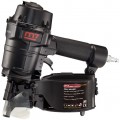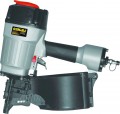Rated pressure
Air pressure for which the
pneumatic nailer/stapler is designed (see "Type"). It is this pressure that the compressor to which the tool is connected should give out: if the pressure is too low, the efficiency will noticeably drop, and if it is too high, it can lead to breakage and even injury.
Magazine angle
The angle at which the magazine is set in the tool. Note that in this case, the angle is measured relative to the perpendicular to the body, more precisely, to the direction of the “shooting” of the fastener; in other words, if the angle of inclination is 0 °, this means that the store is strictly perpendicular to the body. This makes quite a practical sense: an inclined magazine makes it easier to work in hard-to-reach places, driving fasteners at an angle and some other specific tasks, and the greater the deviation of the magazine from the perpendicular, the more pronounced these advantages. At the same time, the real need for such a design is not always required, so many staplers (especially entry-level ones) have a perpendicular magazine, and in such cases the angle of inclination (0 °) is not indicated at all.
Also note that fasteners (especially branded ones, for a tool of a certain brand) can be sold in packs designed for a specific store angle; in such packs, the parts themselves are connected with a slope corresponding to this angle.
Magazine capacity
The number of fasteners that fit in the stapler magazine.
Note that manufacturers tend to indicate the maximum number of parts in the characteristics — that is, the capacity for the thinnest fasteners allowed by the design of the tool. Accordingly, fewer larger parts will fit in the store; this must be taken into account when choosing. Nevertheless, this parameter makes it possible to evaluate the instrument and compare models similar in class to each other.
Large capacity, on the one hand, allows you to work longer without interruptions to recharge the stapler. On the other hand, volume magazines are usually very bulky and can weigh a lot on their own, not to mention the weight of the fasteners loaded in them. Also, if parts are charged one at a time, recharging can become quite a long and tedious affair. Therefore, it makes sense to specifically look for a tool
for 100 parts or more(especially when it comes to thick fasteners) only if the ability to work for a long time without reloading is more important than the disadvantages described above.
Min. nail length
The shortest length of nails (see Fastener Type) that the stapler can handle.
The shorter the fastener, with the same thickness, the less effort is required to drive it, but a nail that is too short simply cannot stand under impact normally. Therefore, for many instruments, this restriction is directly indicated. It is worth paying attention to it first of all if you plan to work with small short nails.
Max. nail length
The longest length of nails (see Fastener Type) that the stapler can handle.
With the same thickness, a longer nail requires not only the appropriate space in the magazine and feed mechanism, but also a higher impact energy — otherwise it simply will not work to hammer it “on the head”. This means that the maximum fastener length is directly related to the power and, accordingly, the overall level of the tool. Recall that a powerful professional tool has the appropriate dimensions and weight, moreover, it is often made pneumatic (for more details, see "Type"). Therefore, it makes sense to look for models that are compatible with long nails only if this is critical for the planned work.
Functions
—
Adjustment of impact force / depth. The ability to adjust the force of impact or the depth of clogging fasteners. These functions are implemented somewhat differently: the impact force is changed by adjusting the power supplied to the striker upon impact, and the driving depth can be set due to a mechanical limiter — for example, by retracting the striker a certain distance back, so that it simply does not was able to move beyond a certain distance. However, the purpose and use of these functions is similar: first of all, they allow you to change the depth to which the fastener is driven into the material. In addition, adjusting the force of impact (namely force) can be useful when working with delicate materials, where too powerful impacts are undesirable. Specific details of the implementation of this function should be clarified in each case separately.
—
Double hit. Possibility of operation of the stapler in the double impact mode. Here, this term means the ability to drive two fasteners at once in one blow — for example, for connections that require increased reliability. Note that double impact most often only works on staples, even if the tool is able to work with other types of fasteners (see above). Firstly, it is for brackets that this possibility is most relevant; secondly, it is much more difficult to implement it for nails or pins.
—
Bending the staple.... The ability of the stapler to work not only for driving staples, but also for bending their legs after installation. The need for bending arises in cases where the tool is used to fasten relatively thin layers of material, and the staples pierce the parts to be fastened through: bent legs provide a secure hold, and are also safer — the risk of scratching or pricking the protruding edge of the staple is minimal. Note that such work requires an anvil of hard material placed under the fastened materials; in some tools with a bending function, the anvil is part of the design, but most often it is not.
— Blade of knife. The presence of a knife blade in the design of the stapler. This feature allows you to use the tool not only for driving fasteners, but also for cutting material — for example, preparing upholstery for furniture. The blades are usually made removable (so that a dull one can be quickly replaced with a fresh one or sharpened with convenience) and have a beveled shape (this allows you to cut with the very tip of the knife, providing high accuracy and accuracy). However, this function is quite specific, therefore it is rare, and mainly among percussion models (see "Type") — only they turn out to be quite light, compact and convenient for use as knives.
— Backlight. The presence in the stapler of its own built-in flashlight, usually directed in such a way as to highlight the place of impact. This feature is extremely useful when working in low light conditions. Note that such conditions can easily arise even under normal ambient lighting: for example, the tool itself often obscures the impact site, worsening visibility and complicating accurate aiming.
— Brushless motor. Such motors do not have the classic carbon brushes found in conventional power tools, whose friction during engine operation leads to additional heating, which leads to unnecessary energy consumption and general engine wear. Refusal to use them allows you to extend the battery life of the tool, on the one hand, as well as the life of the engine, on the other.Case (bag)
The presence of a case or bag in the tool kit.
Such accessories are more convenient than impromptu packaging, they greatly simplify the storage and transportation of both the tool itself and accessories / consumables. At the same time, cases are the most popular in construction staplers — characteristic suitcases made of solid material. Such a suitcase perfectly protects the instrument not only from moisture and dirt, but also from shocks and shocks; it is also often used as the factory packaging in which the tool goes on sale. Bags made of soft material, in turn, are less common: they do not provide such protection against impacts, and they do not resist water / dust as effectively. On the other hand, such packaging itself is less bulky, and when the bag is not needed, it can be rolled up quite compactly.

